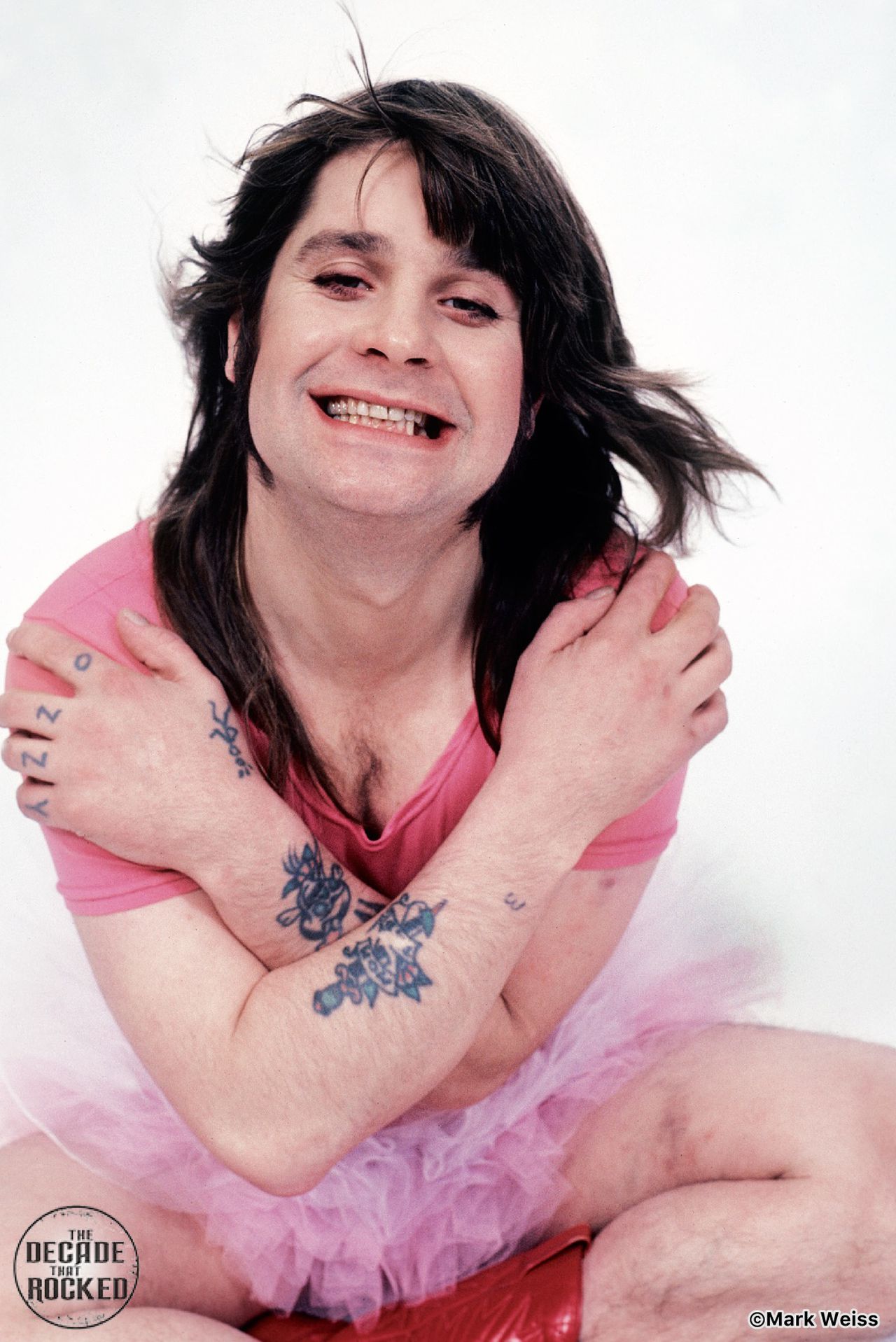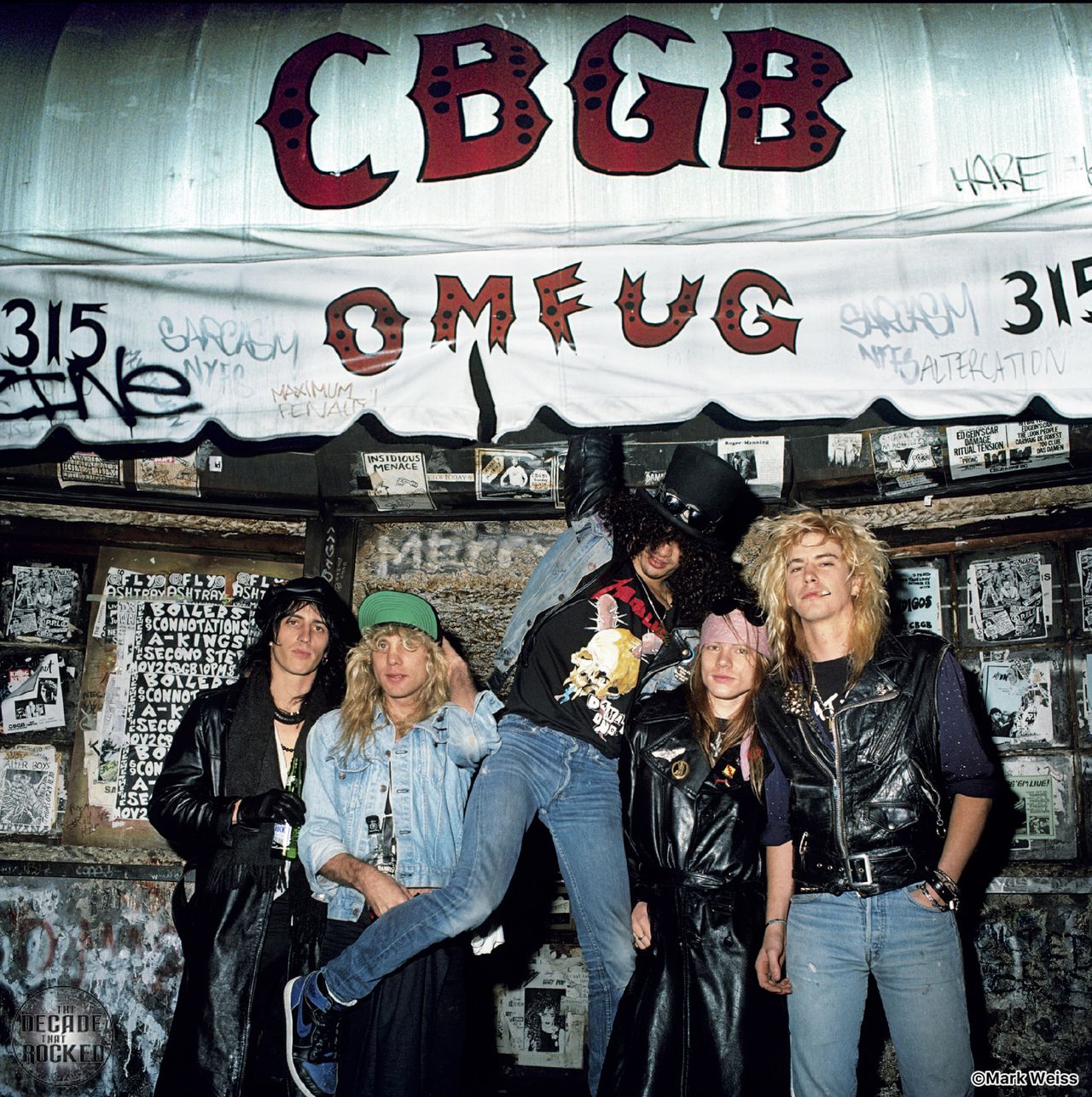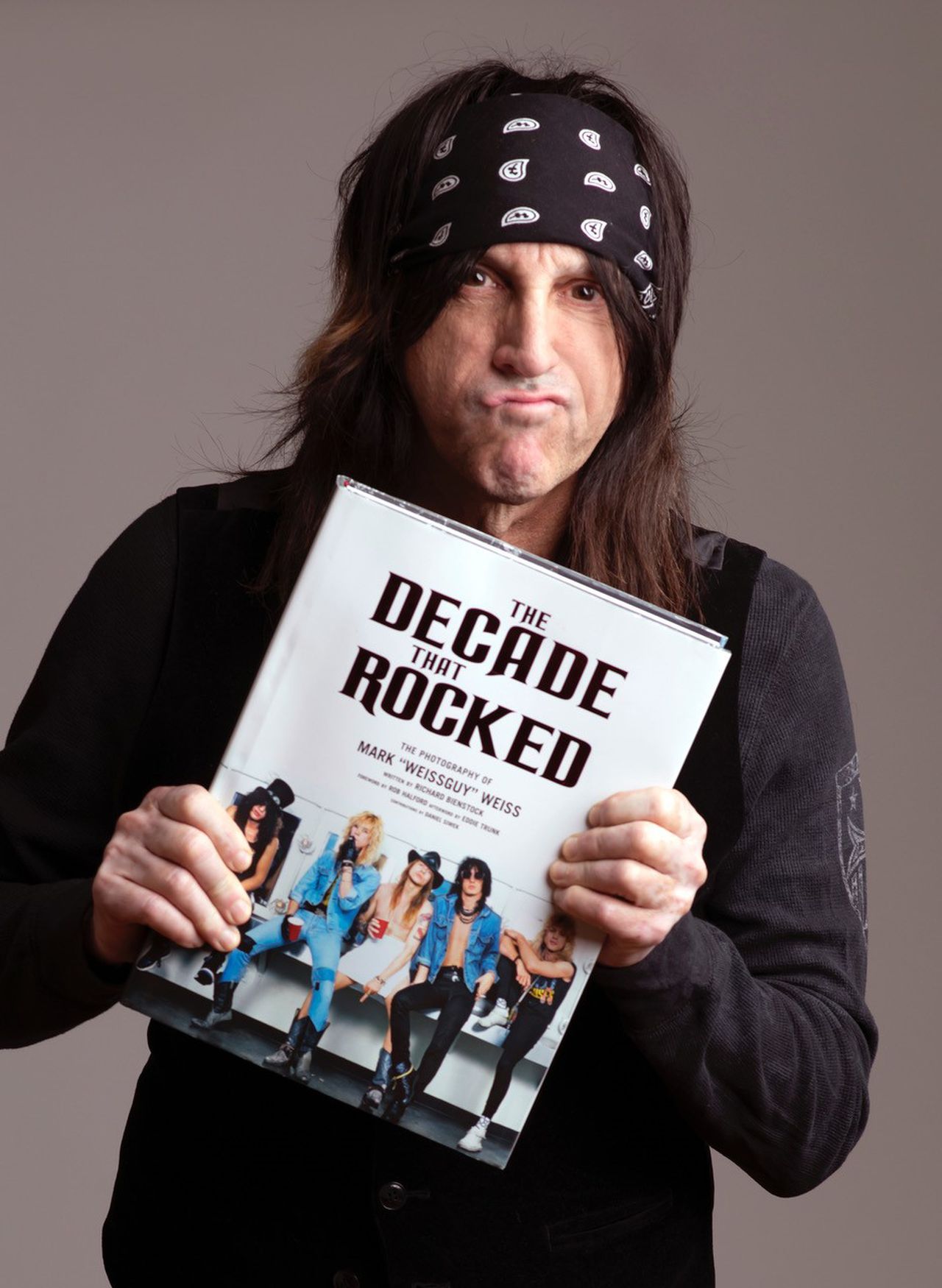The stories behind classic Eddie Van Halen, Mötley Crüe, Ozzy pics
No one was better at capturing the big personalities behind the big sounds of ‘80s rock than photographer Mark Weiss. A New Jersey native, Weiss’ signature shots include metal madman Ozzy Osbourne in a pink tutu. A wild young Guns N’ Roses in front of storied New York punk-rock venue CBGB. Guitar hero Eddie Van Halen being imitated by his actress wife Valerie Bertinelli backstage. Album cover photos for Twisted Sister’s “Stay Hungry,” Cinderella’s “Night Songs” and Bon Jovi’s “Slippery When Wet.”
In 2020, Weiss released a fantastic coffee table book focusing on his ‘80s photos appropriately titled “The Decade That Rocked.” The 378-page, six-pound tome — with text by “Nothin’ But A Good Time” author Richard Beinstock — includes both iconic and previously unpublished Weiss images of rockers ranging from Poison and Skid Row to Mötörhead and Metallica. A personal favorite: A candid photo of GN’R guitarist Izzy Stradlin’ with guitarist Tracii Guns backstage an L.A. Guns show. Judas Priest frontman Rob Halford wrote the book’s foreword. Copies are available via thedecadethatrocked.com.
“The Decade That Rocked” includes many colorful behind-the-scenes photos of classic era, notoriously gnarly Mötley Crüe. In the book, Mötley Crüe bassist Nikki Sixx says of Weiss, “Mark was the perfect guy to have hanging around with us and be a fly on the wall. He was one of the boys. That’s why he did so well with so many artists. He was someone who loved music and loved the lifestyle. He was one of us.”
Weiss is set to appear at ROCKNPOD Expo, set for March 17-19 at the Nashville Fairgrounds. Other special guests at the rocker and podcasting themed weekend, highly recommended for classic hard-rock/metal enthusiasts, include: Mr. Big frontman Eric Martin, Twisted Sister guitarist Eddie Ojeda, comedian and former “That Metal Show” cohost Don Jamieson, Dangerous Toys singer Jason McMaster and many others. More info at nashvillerocknpodexpo.com.
Weiss’ photography is also featured in a new book about Quiet Riot and the band’s late, great frontman Kevin DuBrow, called “Keep On Rollin’.” That book, written by Missy Whitney, is also available at Weiss’ website.
On a recent afternoon, Weiss checked in for a video call interview from his New Jersey home office. Framed platinum and gold records from bands like Dokken hang on the wall behind him. Below are edited excerpts from our conversation.
Rock photographer Mark Weiss and his book “The Decade That Rocked.” (Courtesy Mark Weiss)
Mark, your stylized portraits and backstage-access photos set you apart from other talented rock photographers of the ‘80s. How did you develop that portrait style, with the glamorous backgrounds, lighting and smoke and everything?
Mark Weiss: One of the shoots that influenced me was a Kiss shoot in the late ‘70s where they all had their own fantasy and that always stuck in my mind. I started creating these kinds of, you know, fantasy-like things dating back from 1981, when I first shot Ozzy, dressing him up in the pink tutu and all that. So then I started getting a little taste of like, alright, this is fun, this is not normal. My big thing was when I got hired to do the Twisted Sister “Stay Hungry” [album cover] I built this set that I made up with some input from the guys [in the band] in my studio, and then have total control with lighting and props and pulling all that together.
The success of that gave me a lot of confidence. Because I started getting hired a lot to do album covers. I did “The Last Command” by W.A.S.P. That was a bunch of bones and like two tons of dirt in the studio and then the sky background.
I started going to California and go to these prop houses, having a field day and making stuff up. Like, in 1985, I did Mötley Crüe “Theater of Pain” and I did some normal photos with different color backgrounds. But then they wanted to do this fantasy with Rolls Royce and tommy guns and suits. And that was a big ordeal. But it was fun.
You’ve shot so many of the biggest rock musicians. Were there any musicians you wanted to shoot but didn’t because logistics or scheduling didn’t work out?
No. I would make sure that on those kinds of shoots I would be available – album covers, touring with Ozzy in Japan and things like that. I mean, it may have happened, but I always took the better job. I never broke a commitment, but I was able to juggle things. It was just fun. So I didn’t want to let anything go to any other photographer. If it was thrown in my lap would do the best I could, and have something that we could talk about 40 years later.

A photo of heavy-metal singer Ozzy Osbourne from Mark Weiss’ book “The Decade That Rocked.” (Courtesy Mark Weiss)
You mentioned Ozzy Osbourne and he recently announced his retirement due to his health. With all he’s done for heavy music both solo and with Black Sabbath, do you have any cool memories of working with Ozzy?
That shoot that I first did with Ozzy with him in the bathtub and him in the pink tutu, I kind of hung out with him when the “Blizzard of Ozz” [Osborne’s 1980 debut solo album] was released. I was working for Circus Magazine. I mean, I’m only 21-years-old at this time.
So I got this assignment to do this, and we just kind of connected pretty quickly. When I told him to do something, he would do it. He’s like, “Is that OK, Mark?” I’m this punk kid and he was in Black Sabbath. He gave me the confidence by giving me the respect to trust me to do what I do. And from that, we, you know, became fast friends and with the family and whatnot. Sharon [Osborne, Ozzy’s wife and manager] and Ozzy were the first ones to like take me in as a photographer, like on the road, and include me in family things and kind of be part of the family.
And Ozzy had so many bands opening up for him. When Mötley Crüe opened up [for Osbourne circa 1984 ], I had already shot Mötley too so that was fun. Metallica, first time I met them in ‘86, when I shot Cliff [Burton, late bassist] before he passed and then a month later, I’m going to San Francisco doing the new publicity photos on the San Francisco bridge with Jason [Newstead, who joined Metallica after Burton’s death in a tour bus accident].
So all those things lead to stuff. So I really owe a lot to them [the Osbournes]. And I paid back the favor by getting them [longtime Ozzy Osbourne guitarist] Zakk Wylde, a couple years later. I introduced them.
Of all the bands you shot live or toured with, is there a band that doesn’t get enough credit for being a really good live band back then?
I mean, most of those bands were really good live. My favorites were Aerosmith — shooting Steven [Tyler, Aerosmith frontman], he jumps all over the place, Mötley Crüe, of course, and Ozzy too. Just the ones that you would think. Something about that music, the energy was just always like on speed. Just really full throttle ahead.
So, for me as a photographer, I had three cameras dangling, and I was film back then. When one ran out of film, I’d get another one. It was just all over the place. So at the end of the day, I come back with like, you know, 20, 30 rolls of film. That would be like maybe 700 photos, where today, you know, I can shoot 3000 photos and not even think about it.
For people who haven’t read your book, how did you get your start?
My first polished photograph, what happened was I started going to concerts and sneaking my camera in, in like ‘74, for the Elton John show. And then in ‘76 I started getting closer to the stage and started developing my pictures, and with Peter Frampton I snuck in the first night … I would actually pay the guard off at the front door and sneak all my camera stuff in, and then I would get to the front and when the lights went out, I would jump over the barricade and then pull the seats apart so I could get a nice spot like, you know, 10 feet back.
And then the next day I would, I’d stay up all night and sell them out of my high school locker and then get on a train, that’s in New York, which is like an hour away, so I was selling them on the train. And then I sold them in front of the concerts.
So I did that maybe a couple years. And I got arrested in ‘77 for doing that at a Kiss show, and that was my big break, believe it or not. I was like, “What am I going to do now?” I took my Circus Magazine, which was the big rock mag back then, which I had a subscription to, and I just looked at the address and went to New York City. I just hopped on the same train and took a subway and just knocked on the door with my loose photos.
And it was just good timing. The secretary took a liking to me, and she got me an appointment like three hours later with the art director. And then a few months later, she said, “Hey, do you have any pictures of Aerosmith? They’re not letting anyone shoot them. I said, “Yeah.” I snuck in and shot them at Giants Stadium. Dropped them off and two months later, it was the centerfold of Steven Tyler.

A photo of rock band Guns N’ Roses from Mark Weiss’ book “The Decade That Rocked.” (Courtesy Mark Weiss)
Got a good Eddie Van Halen story from your shoots with Van Halen?
I first shot him in ‘79, I was working for Circus. I didn’t really have a backstage pass. But I got there early, and I introduced myself and I showed him the Aerosmith centerfold and they were starting to do OK in the theaters. They weren’t an arena band yet. And once I said “Circus,” it got me in the door. I said, “Can I take some photos?” and [Van Halen bassist] Michael Anthony was there and said yes and so I took some of them.
Then I asked Eddie, he didn’t respond he just smiled so I took that as a yes. And that’s kind of been a little inside joke. A few years later, I’m shooting for them and they’re giving me full access to go do whatever I want. I always say, “Hey, can I do some photos?” And he would just again, give me that smile.
But remember backstage at the last weekend in Detroit, Valerie [Bertinelli] was there and they were backstage. They were just kind of hanging around, and I said, “Hey, can I get a photo with you, Valerie?” and she came over and had a beer in her hand and a cigarette. They look like brother and sister.
When the ‘80s turned into the ‘90s, a lot of the newer bands were less into visual image. But there were some of those ‘90s rockers who had a cool style, like Scott Weiland from Stone Temple Pilots. Were there many musicians after the ‘80s who you thought had the star power and visual panache on the level of the big ‘80s bands?
I worked for [the music magazine] Metal Hammer back then too, and they were going with those kinds of bands. I shot Soundgarden, I did a shoot with Alice in Chains, a bunch of bands, but they weren’t interested. You know what I mean? So I didn’t put any energy into it. And that was it. A little later on, I would shoot bands like Sum 41, and I did a lot with Blink 182. They were fun.
But then I started shooting [pop singer] Christina Aguilera and I ended up doing an album cover for her. I was shooting [rappers] Nelly and Lil’ Bow Wow and [R&B singer] Usher and [pop group] Black Eyes Peas. Those were like the new rock stars that I gravitated to because they were fun to shoot.
MORE ON ROCK MUSIC:
Ann Wilson talks Heart, new Muscle Shoals album, Led Zeppelin
Wolfgang Van Halen talks Mammoth WVH, Guns N’ Roses tour, Van Halen
Now here’s an ‘80s hard-rock reunion done right
What do the band Foreigner and ‘Nightmare on Elm Street′ have in common?
Zakk Wylde talks Ozzy Osbourne, Guns N’ Roses, Black Label Society
